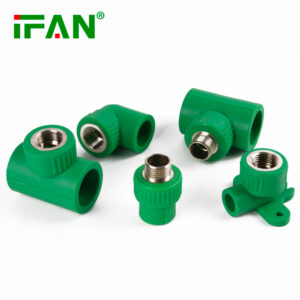PPR Pipe and Fittings
Whatsapp Us
Share
Description
PPR Pipe and Fittings: Comprehensive Introduction
PPR (Polypropylene Random) pipes and fittings are crucial components used in plumbing systems for the distribution of water and other fluids. These pipes and fittings are made from high-quality polypropylene, which offers exceptional durability, chemical resistance, and thermal insulation properties. Let’s explore the various types of PPR pipes and fittings and the advantages they offer.

Types of PPR Pipes and Fittings
PPR Pipes: PPR pipes are available in different diameters and lengths, making them suitable for various plumbing applications. These pipes exhibit excellent resistance to high temperatures and pressure, ensuring long-lasting performance.
PPR Coupling: PPR couplings are used to connect PPR pipes of the same diameter. These fittings provide secure and leak-proof connections, ensuring the efficient flow of water.
PPR Tee: PPR tees are used to create branch connections in plumbing systems. They enable the distribution of water in multiple directions, maintaining the flow rate and preventing pressure loss.
PPR Elbow: PPR elbows have a 90-degree bend, allowing for changes in the direction of PPR pipes. These fittings are essential for navigating corners and obstacles in plumbing systems.
PPR Reducer: PPR reducers facilitate the connection of pipes with different diameters. They ensure a smooth transition between two pipes, maintaining the flow rate and preventing pressure loss.
PPR Union: PPR unions provide a detachable connection in plumbing systems. They consist of a socket, an O-ring, and a nut, allowing for easy disconnection, maintenance, and repair.
PPR Valve: PPR valves are used to control the flow of water or other fluids in plumbing systems. These valves can be manually operated to open or close, regulating the water supply.

Advantages of PPR Pipes and Fittings
Durability: PPR pipes and fittings are highly durable, resistant to impact, and capable of withstanding long-term use without degradation.
Chemical Resistance: PPR pipes and fittings exhibit excellent resistance to chemicals, making them suitable for various plumbing applications without the risk of corrosion or degradation.
Thermal Insulation: PPR pipes offer excellent thermal insulation properties, minimizing heat loss and ensuring energy efficiency in hot water plumbing systems.
Easy Installation: PPR pipes and fittings are lightweight and easy to handle, simplifying the installation process and reducing labor and installation costs.
Leak-proof Joints: The precise design of PPR pipes and fittings ensures secure and leak-proof joints, preventing water leakage and reducing the risk of damage to the plumbing system.
Low Maintenance: PPR pipes and fittings require minimal maintenance, reducing overall maintenance costs and ensuring long-term reliability.
In conclusion, PPR pipes and fittings are essential components in plumbing systems for water and fluid distribution. With various types available, including pipes, couplings, tees, elbows, reducers, unions, and valves, PPR pipes and fittings offer advantages such as durability, chemical resistance, thermal insulation, easy installation, leak-proof joints, and low maintenance. These qualities make PPR pipes and fittings a preferred choice for efficient and reliable plumbing systems in residential, commercial, and industrial applications.

Related products
-
PPR Fittings
Green Plasitc PPR Fittings
-
PPR Fittings
PPR Fittings
















